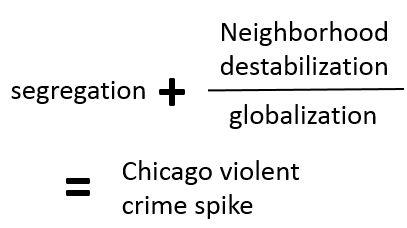Chicago's violent crime problem can be understood through this formula:

It's a simplistic, reductionist, even crude, but it explains the roots of Chicago's crisis as well as anything. read more »
Chicago's Crime Wave Understood: Complex Problem, Simple Formula
by Pete Saunders 03/03/2017
Chicago's violent crime problem can be understood through this formula:
It's a simplistic, reductionist, even crude, but it explains the roots of Chicago's crisis as well as anything. read more » »
Subjects:
The Economics of Dependency
by Sami J. Karam 03/02/2017
This article first appeared at Foreign Affairs. How countries hit the demographic sweet spot. Demographics are among the most important influences on a country’s overall economic performance, but compared with other contributors, such as the quality of governance or institutions, their impact is underappreciated. read more » »
Subjects:
Los Angeles Traffic: Likely To Worsen with Higher Densities
by Wendell Cox 03/01/2017
A few recent days driving the Los Angeles freeways impressed me with how different they are from in most other places in the country. The intensity of the traffic is astounding. Even on the weekend, travel over Sepulveda Pass on the San Diego Freeway (I-405) was highly congested. Traffic really never stopped, but frustratingly inched along for parts of the way and approached 60 miles per hour on other parts. A Saturday trip I feared might take an hour and a half was completed from Simi Valley in less than 60 minutes. read more » »
Subjects:
Is L.A. Back? Don't Buy the Hype.
by Joel Kotkin 02/27/2017
With two football teams moving to Los Angeles, a host of towers rising in a resurgent downtown and an upcoming IPO for L.A.'s signature start-up, Snapchat parent Snap Inc., one can make a credible case that the city that defined growth for a half century is back. According to Mayor Eric Garcetti, the Rams, Chargers and the new mega-stadium that will house them in neighboring Inglewood, show that “that this is a town that nobody can afford to pass up.” read more » »
The True Legacy of Gov. Jerry Brown
by Joel Kotkin 02/26/2017
The cracks in the 50-year-old Oroville Dam, and the massive spillage and massive evacuations that followed, shed light on the true legacy of Jerry Brown. The governor, most recently in Newsweek, has cast himself as both the Subcomandante Zero of the anti-Trump resistance and savior of the planet. But when Brown finally departs Sacramento next year, he will be leaving behind a state that is in danger of falling apart both physically and socially. read more » »
Subjects:
Automation, Artificial Intelligence, and Projectile Wooden Shoes
by John Sanphillippo 02/24/2017
Sabotage has its root in the French word sabot, which is a kind of wooden shoe. In the early days of the Industrial Revolution craftsmen would throw their shoes into the gears of factory machines. Skilled labor was being replaced with mechanical production, undermining traditional professions, reducing incomes, and removing the social standing of workers. Wealth flowed up to the people who owned the factories and controlled the levers of political power. Sabotage was a form of negotiation. read more » »
Subjects:
Dallas-Fort Worth & Dayton: World Large City Least Congestion: 2017 Tom Tom Traffic Index
by Wendell Cox 02/23/2017
Dallas-Fort Worth and Dayton Ohio have the least traffic congestion among larger cities (urban areas) in the world, according to the 2017 Tom Tom Traffic Index. Dallas-Fort Worth had the shortest average all day delay, at 18 percent of the 43 cities with more than 5 million population. Dallas-Fort Worth also had the least average peak period traffic delay. This is the second year in a row the Dallas Fort Worth has had the best all day traffic congestion. read more » »
Subjects:
The Economic Implications of Housing Supply
by Randal OToole 02/22/2017
A new paper with the above title by urban economists Edward Glaeser and Joseph Gyourko provides more evidence to back up the Antiplanner’s recent paper on the New Feudalism. One of the major points of that paper was that the Obama administration’s plan to force suburbs to relax zoning codes to allow higher density housing is not the solution to housing affordability problems. read more »
Subjects:
The Midwest, Redefined
by Pete Saunders 02/21/2017
What if the region we broadly understand as the Midwest, stretching from the foothills of the Alleghenies to the high plains, and from the chilly northern Great Lakes to the Ohio, Mississippi and Missouri river valleys, had been allowed to develop as organically as its eastern and southern -- and even western -- neighbors? If it had, it would be far better understood, have a much stronger cultural clarity, and more recognized for its contributions to American society and economy. read more » »
Subjects:
Neo-Stalinists Versus the Sons of Anarchy
by Joel Kotkin 02/20/2017
In one of the great scenes from the movie “Dr. Zhivago,” based on the novel by Soviet author Boris Pasternak, a young Bolshevik commander explains to the idealistic physician that “the private life is done in Russia. History has killed it.” In America today, it also seems increasingly impossible to separate personal life from the political. In awards shows, sports broadcasts and fashion runways — which once provided escapes from politics — we find endless passionate anti-Trump protests and denunciations. Even corporations, like Under Armour, have faced opprobrium — and even boycotts — for daring to support Trump. Nordstrom faced a possible boycott for carrying a now-canceled fashion line of his daughter, Ivanka. read more »
Subjects:
|
Subscribe to NG ArticlesThe Coming of Neo-Feudalism
Infinite Suburbia
BooksAuthored by Aaron Renn, The Urban State of Mind: Meditations on the City is the first Urbanophile e-book, featuring provocative essays on the key issues facing our cities, including innovation, talent attraction and brain drain, global soft power, sustainability, economic development, and localism. Popular ContentRecommended Books
Blogroll and Partner SitesUser login |